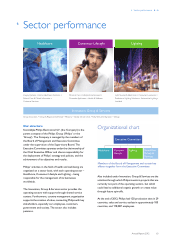Philips 2012 Annual Report Download - page 57
Download and view the complete annual report
Please find page 57 of the 2012 Philips annual report below. You can navigate through the pages in the report by either clicking on the pages listed below, or by using the keyword search tool below to find specific information within the annual report.
5 Group performance 5.3.1 - 5.3.1
Annual Report 2012 57
Green Innovation per sector
in millions of euros ■-Healthcare_■-Consumer Lifestyle
■-Lighting_■-Group Innovation
600
400
200
0
2008
54
29
151 41
275
2009
50
61
185 44
340
2010
60
56
230 46
392
2011
85
67
291 36
479
2012
136
70
325 38
569
Energy efficiency of products
Energy efficiency is a key Green Focal Area for our Green
Products. Our analysis has shown that about 97% of the
energy consumed during the use phase of our products is
attributable to Lighting products. The remaining 3% is split
over Consumer Lifestyle and Healthcare. Therefore, we
focus on the energy efficiency of our Lighting products in
the calculation. The annual energy consumption per
product category is calculated by multiplying the power
consumption of a product by the average annual operating
hours and the annual pieces sold and then dividing the light
output (lumens) by the energy consumed (watts). The
average energy efficiency of our total product portfolio
improved some 7% in 2012 (17% compared to 2009).
Although LED sales advanced well, demand for
conventional lighting remained fairly stable due to the
challenging economic environment. Since the number of
traditional lamps sold is significantly higher than LEDs, the
energy efficiency improvement of the total Lighting
portfolio in 2012 was limited. Our target for 2015 is a 50%
improvement compared to the 2009 baseline. Further
details on this parameter and the methodology can be
found in the document ‘Energy efficiency of Philips
products’ at www.philips.com/sustainability.
Closing the material loop
In 2010 we calculated the 2009 baseline for global
collection and recycling amounts at around 37,000 tonnes
(excluding TV), based on the data retrieved from the
WEEE collection schemes and from our own recycling and
refurbishment services (mainly Healthcare). The amount
of collection and recycling for 2011 (reported in 2012)
was calculated at 43,000 tonnes as we noted an increase
in recycled Lighting products.
We calculated the amount of recycled materials in our
products in 2012 at some 12,000 tonnes (2011: 10,000
tonnes), by focusing on the material streams plastics,
aluminum and refurbished products, depending on the
relevance in each sector.
Our target is to double the global collection and recycling
and the amount of recycled materials in our products by
2015 compared to 2009. Further details on this parameter
and the methodology can be found in the document
‘Closing the material loop’ at
www.philips.com/sustainability.
Healthcare
Philips Healthcare develops innovative solutions across
the continuum of care in partnership with clinicians and
customers to improve patient outcomes, provide better
value, and expand access to care. While doing so, we take
into account all Green Focal Areas and aim to reduce
environmental impact over the total lifecycle. Healthcare
investments in Green Innovation in 2012 amounted to
EUR 136 million with a focus on energy efficiency and dose
reduction. Other areas covered include increased levels
of recycled content in our products and closing the
materials loop, e.g. through upgrading strategies, parts
harvesting and refurbishing programs as well as reducing
environmentally relevant substances from our products.
The investments reflect the increasing interest that we
see in societies across the globe for green hospitals and
reduced environmental impact of healthcare. Philips
Healthcare actively supports a voluntary industry initiative
for improving the energy efficiency of imaging equipment.
Moreover, solutions are being developed to support
hospitals in identifying and realizing energy efficiency
opportunities in their operations.
Consumer Lifestyle
Green Innovation at Consumer Lifestyle amounted to
EUR 70 million. The sector continued its work on
improving the energy efficiency of its products, closing the
materials loop (e.g. by using recycled materials in products
and packaging) and the voluntarily phase-out of polyvinyl
chloride (PVC), brominated flame retardants (BFR) and
Bisphenol A (BPA) from food contact products. In
particular, the Personal Care business launched many
products which are completely PVC/BFR-free. Overall
this has resulted in an increase in Green Product sales at
the Personal Care, Domestic Appliances, Health &
Wellness and Coffee businesses.
Lighting
At Lighting, we strive to make the world healthier and
more sustainable through energy-efficient lighting
solutions. In 2012 Lighting invested EUR 325 million to
























